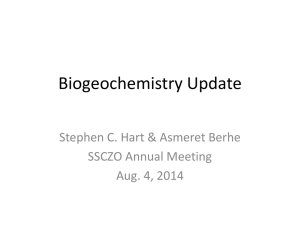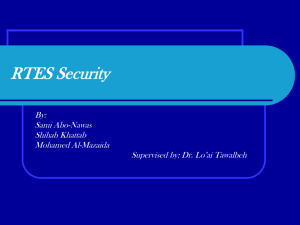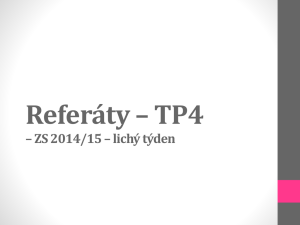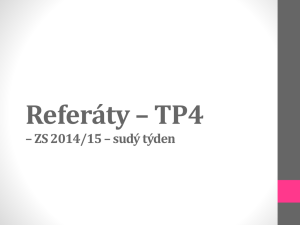SCI2C specifications and limitations: Memory Optimization
advertisement
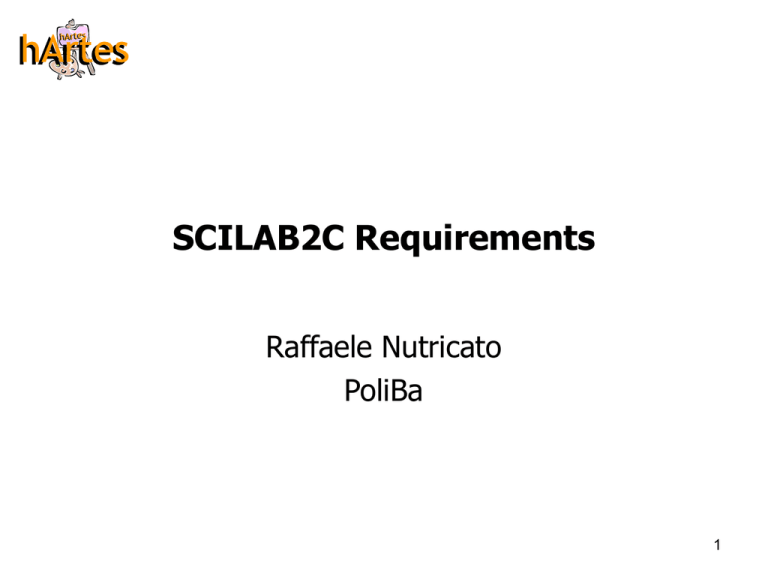
hArtes
es
rtes
hArt
hA
SCILAB2C Requirements
Raffaele Nutricato
PoliBa
1
hArtes
es
rtes
hArt
hA
Agenda
• Open Issues
• SCILAB2C specifications and limitations
2
hArtes
es
rtes
hArt
hA
Open Issues: I/O
(Prof. Piazza) We need specifications
concerning the input and output data
management. Two approaches can be
adopted:
1. Input/Output files SCI2C will support
file management functions
2. Input/Output buffers SCI2C will not
support file management functions.
3
hArtes Open Issues: Complex Numbers
es
rtes
hArt
hA
• Need to define an implementation for
complex numbers…
• For now we have a strong interface
(but it may decrease efficiency)
4
hArtes Open Issues: Complex Numbers
es
rtes
hArt
hA
************
We proposed 2 implementations: ************
• Standard C-99 :
#include <complex.h>
[…]
double a=1.0; double b=2.0;
float c=3.0; float d=4.0;
double complex z = a+b*I;
float complex w = c+d*I;
•
Hand made Complex structure with strong interface that hide the
real implementation :
(Only given as example, must be improve for efficiency)
#include <doubleComplex.h>
#include <floatComplex.h>
[…]
double a=1.0; double b=2.0;
float c=3.0; float d=4.0;
doubleComplex z = DoubleComplex(a,b);
floatComplex w = FloatComplex(c,d);
5
hArtes Open Issues: Complex Numbers
es
rtes
hArt
hA
******* Implementation depends on compilation options *******
/*
** \function DoubleComplex
** \brief construct a Double Complex .
*/
doubleComplex DoubleComplex(double real, double imag) {
doubleComplex z;
#ifndef
STDC99
z.real = real;
/*
** Hand made Double Complex definition
** {
*/
struct double_complex
{
double real;
double imag;
};
typedef struct double_complex doubleComplex;
/*
** }
*/
z.imag = imag;
#else
z = real + I * imag;
#endif
return z;
}
/*
** Standard C99 Complex
** {
*/
#include <complex.h>
typedef double complex doubleComplex;
/*
** }
*/
But we may add another implementation
if it’s more efficient.
/*
** Another Hand made Double Complex definition
** {
*/
struct double_complex
{
double z[2];
};
typedef struct double_complex doubleComplex;
/*
** }
*/
6
hArtes
es
rtes
hArt
hA
Open Issues: String
manipulation
• Do we need support for string
manipulation? Is it important for DSP?
7
hArtes
es
rtes
hArt
hA
SCI2C specifications and
limitations
• Most of the specifications for the SCILAB2C tool
come from previous meetings with other hArtes
partners (mainly INRIA)
• They have been proposed in order to reach the
final goal (Dr. Gomez): to produce an
optimized code. “Optimized" means that
the generated C code does not include any
part of Scilab interpreter. So it should be
very small and efficient.
8
hArtes
es
rtes
hArt
hA
SCI2C specifications and limitations:
Memory Optimization
Optimization of memory usage requires:
1.
Function Arguments are passed by reference.
2.
No dynamic memory allocation
9
hArtes
es
rtes
hArt
hA
SCI2C specifications and limitations:
Memory Optimization
Function Arguments are passed by reference (in
Scilab/Matlab they are passed by value).
This means that:
•
the body of function cannot change the input parameter values.
or…
•
a warning can be issued by the SCILAB2C tool when a function
input prm is modified by the body of the function so that the user
can change the code according to the warning message.
Sol.:
Ex.:
Function c = test(a,b)
c = a + b;
a = rand();
c = c + a;
Warning here
Function c = test(a1,b)
a = a1;
c = a + b;
a = rand();
c = c + a;
10
hArtes
es
rtes
hArt
hA
SCI2C specifications and limitations:
Memory Optimization
No dynamic memory allocation.
This means that:
•
No dynamic array extension
Ex.: A = [A B]; NOT ALLOWED!!!!
•
No support for Scilab t-list type.
•
The code must be annotated: users must specify
precision and size of data (for local/global vars and
function prms)
11
hArtes
es
rtes
hArt
hA
SCI2C specifications and limitations:
Memory Optimization
Examples of code annotation:
Annotated version
//SCI2C: PRECISION float;
Non-Annotated
version
. . .
c = foo3(a,b);
function y = foo3(x,z)
y = abs(x) + det(z);
endfunction
Annotations avoids dynamic
memory annotation + crazy
code!!!
//SCI2C: a = complex2D(10,15)
//SCI2C: b = real2D(10,10)
//SCI2C: c = real2D(10,15)
. . .
c = foo3(a,b);
//SCI2C: y.size = x.size
//SCI2C: y.type = z.type
function y = foo3(x,z)
y = abs(x) + det(z);
endfunction
12
hArtes
es
rtes
hArt
hA
Not known the size
of the memory that
have to be
allocated
SCI2C specifications and limitations: Memory
Optimization
Examples of crazy code:
Somtimes it can work, but if M =
random…
c = det(RandomMtx());
c = det(RandomMtx(M));
function B = RandomMtx()
M = round(10*rand());
B = rand(M,M);
endfunction
function B = RandomMtx(M)
B = rand(M,M);
endfunction
Rule: Non-crazy code is code that can be annotated by using relationships
as OutPrmSize=fnc(InPrmSize). This ensures that the sizes of
matrices can be computed at compile time.
A = rand(10,15)
C = transpose(A);
OK!!!
//SCI2C: B.size = [A.size(2), A.size(1)]
//SCI2C: B.type = A.type
function B = transpose(A)
B = A.’;
endfunction
A = rand(10,10)
C = determinant(A);
OK!!!
//SCI2C: B.size = [1, 1]
//SCI2C: B.type = real
function B = determinant(A)
B = abs(det(A));
endfunction
13
hArtes
es
rtes
hArt
hA
SCI2C specifications and limitations: Memory
Optimization
Not known the size
of the memory that
have to be
allocated
Examples of crazy code:
Not known the size and type of the output
matrix
c = zeromatrix(2);
c = ReferenceMatrix(-11);
function B = zeromatrix(a)
if (a==1)
B = zeros(10,10);
end
if (a==2)
B = zeros(20,20);
end
if (a==3)
B = zeros(30,30);
end
endfunction
function B = ReferenceMatrix(a)
if (a==1)
B = zeros(10,10);
elseif (a==2)
B = zeros(20,20);
elseif (a==-1)
B = ones(10,10);
else
B = ones(20,20)+%i*ones(20,20);
end
endfunction
Non-crazy code is code that can be annotated by using relationships as
OutPrmSize=fnc(InPrmSize)
14
hArtes
es
rtes
hArt
hA
SCI2C specifications and
limitations
• Functions with a variable number of input/output
arguments. In calling a function, users have always to
specify all input/output arguments. Prof. Piazza says
that it is a strong limitation. We can check (with
INRIA) if it is possible to guarantee variable
input/output arguments only for the SCI2C DSP library
(not for all the scilab functions written by the user).
• Change for the moment…
• SCI2C DSP library is the library that INRIA is
developing in C.
• The SCI2C DSP library will be composed of the
following functions:…
15
hArtes
es
rtes
hArt
hA
SCI2C specifications and
limitations
Basic Statements
Support for:
•for
•while
•if, else, elseif
•Complex forms of the for statement.
From scilab help:
– Simple: for j = 2:3:n-1, a(j,j) = j; end;
– Complex: for e=eye(3,3),e,end
From Matlab help: Long loops are more memory efficient
when the colon expression appears in the FOR
statement since the index vector is never created.
16
hArtes
es
rtes
hArt
hA
SCI2C specifications and
limitations
Auxiliary functions
• find
• isempty
• isnan
• rand
• Op:
• size
• type
17
hArtes
es
rtes
hArt
hA
SCI2C specifications and
limitations
DSP functions
•
FIR
•
IIR
•
hilbert
•
conv
•
conv2d
•
cvexp
•
fft
•
ifft
•
levinson
•
lpc2cep
•
xcorrc
18
SCI2C specifications and
limitations
hArtes
es
rtes
hArt
hA
Elementary functions
•
acos
•
acosh
•
asin
•
asinh
•
atanh
•
cos
•
cosh
•
exp
•
log
•
log10
•
sin
•
sinh
•
sqrt
•
tan
•
tanh
•
vatan2
•
vexp10v
19
hArtes
es
rtes
hArt
hA
SCI2C specifications and
limitations
Matrix Operators
eq
ne
lt
gt
le
ge
Relational operators.
- Equal
==
- Not equal
~=
- Less than
<
- Greater than
>
- Less than or equal
<=
- Greater than or equal
>=
and
or
not
Logical operators.
- Logical AND
&
- Logical OR
|
- Logical NOT
~
Arithmetic operators.
plus
minus
uminus
mtimes
times
mpower
power
mrdivide
rdivide
- Plus
- Minus
- Unary minus
- Matrix multiply
- Array multiply
- Matrix power
- Array power
- Slash or right matrix divide
- Right array divide
+
*
.*
^
.^
/
./
• abs, det, inv, mchol, sum, trace
20
hArtes
es
rtes
hArt
hA
SCI2C specifications and
limitations
String handling ???
• part
• strcat
• strcmp
• strindex
• strsubst
21
hArtes
es
rtes
hArt
hA
SCI2C specifications and
limitations
File Management ???
• mclose
• mget
• mopen
• mprintf
• mseek
22
hArtes
es
rtes
hArt
hA
SCI2C specifications and
limitations
•
Max dimension is 2D
•
Each source file must contain only one function declaration NO
multiple functions can be written into the same file.
•
N-ary expressions: Expressions as E=A+B+C+D will not be converted
as:
– E[i] = A[i] + B[i]+ C[i] + D[i].
– They will be converted as:
– E = sum(A,sum(B,sum(C,D)));
– To force the first implementation the user har to re-write the Scilab code as in
the following example:
– for i=1:N
–
E[i] = A[i] + B[i]+ C[i] + D[i]
– end
– No support for optimizations that are already available in the C compiler.
23
hArtes
es
rtes
hArt
hA
SCI2C specifications and
limitations
• DATA TYPES SUPPORTED:
– TYPES: Real/Complex
– PRECISION: Float/Double
– Integer precision is supported only for the counter
variables of the “for” loops.
– The precision of data can be float or double and it is
the same for all the variables (except for counter
variables in the “for loops”).
24
hArtes
es
rtes
hArt
hA
Control of temp variables
Support for temp variables generation control (remove
dependences + src != dest):
• a = (b + c + h) * (d + e);
• a = b + c;
There are some
• a = a + h;
mAgic functions
• temp1 = d + e;
that don’t allow
src=dest
• a = a * temp1;
Or
• temp1 = b + c;
• temp2 = temp1 + h;
• temp3 = d + e;
• a = temp2 * temp3;
25
hArtes
es
rtes
hArt
hA
End Of Presentation
Thank you!
Raffaele Nutricato
26
